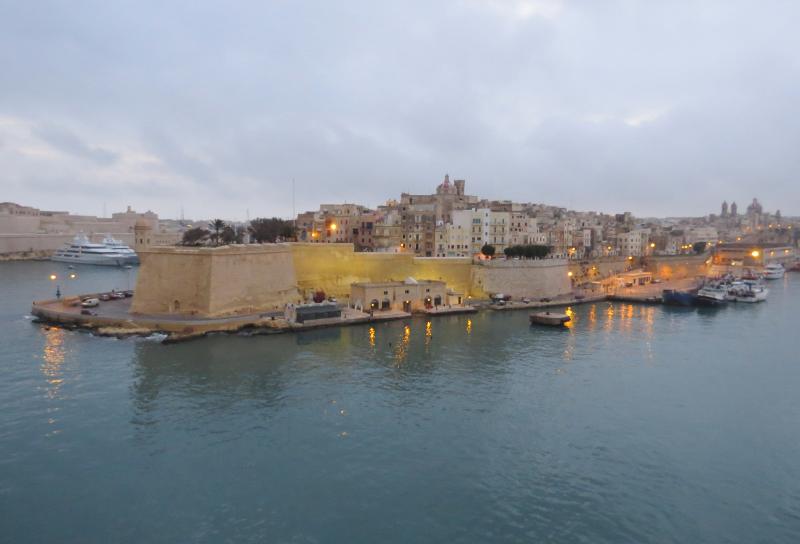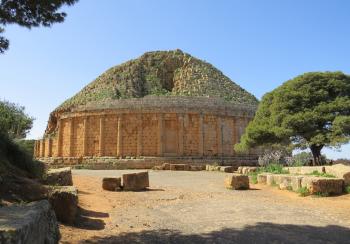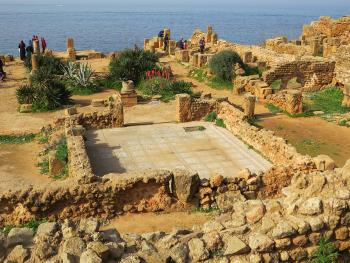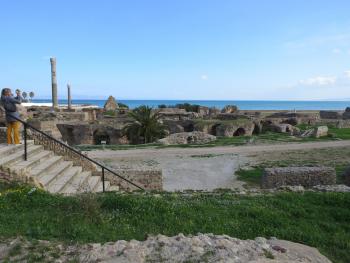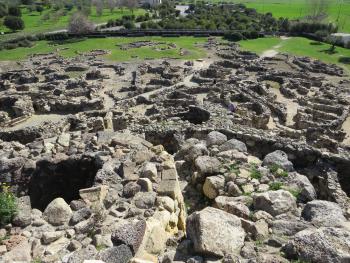Choosing the tours less taken on a southern Mediterranean cruise
This article appears on page 6 of the November 2017 issue.
In February 2017, we took Viking Ocean Cruises’ “Secrets of the Southern Mediterranean” cruise, from Civitavecchia, Italy, to Barcelona, Spain, stopping at ports in Malta, Tunisia, Sardinia and Algeria. We are both historians, and a primary reason for our taking the cruise was to see the ancient ruins of Barumini on the island of Sardinia, Carthage in Tunisia and the Tipasa Roman ruins and the Royal Mausoleum of Mauretania in Algeria. All four are UNESCO World Heritage Sites and were accessible through tours from the ship.
These particular sites had another feature in common. They seemed to be among the least popular tours offered on the cruise for a variety of reasons, including distance from the port, level of fitness required to experience the sites and the added expense of taking optional tours instead of the cruise’s complimentary, included tours.
Getting there
We made our own flight arrangements on British Airways (BA) from Los Angeles (LAX) to London and on to Rome at a round-trip cost of $8,300 for business-class seats for the two of us. (The return flight was from Barcelona via London to LAX.)
Since we had spent a week in Barcelona the year before, on this trip we selected British Airways because it was the only airline with a flight leaving from Barcelona late enough for us to avoid an overnight stay on the day we disembarked.
There were less expensive routings with US layovers, but we prefer taking a nonstop flight to Europe before making connections to our final destination. If we are going to be stuck somewhere or miss a connecting flight, we would rather be in London or Paris than Newark or Atlanta!
BA’s food and wine selection was very good, but their lay-flat seats on the Airbus 380, while very comfortable, were in an odd configuration, with one seat facing one direction and the adjoining seat facing the opposite direction. That meant that whoever had the window seat had to step over another passenger’s legs to enter the aisle while the seats were in the lay-flat position. It is especially awkward for a couple traveling together in adjoining seats because the passenger who has to be stepped over isn’t your companion.
We landed in London early so were able to use BA’s London-Heathrow lounge prior to our flight to Rome. It offered a variety of complimentary light meals, snacks and drink options as well as free Wi-Fi.
Civitavecchia
Rome’s seaport, Civitavecchia, is a historic city located 50 minutes from the airport. Some travelers choose to spend a few days in the city of Rome prior to a cruise departing from this port, but since we had been to Rome several times, we decided to spend two nights in Civitavecchia instead so we could explore the city and acclimate to the time change.
We had been to this port city before but had taken advantage of tours that took us out of town. This time we wanted to explore the town at our leisure, since it has ancient sites and a vibrant cultural life that few travelers seem to experience.
We had reserved a “Platinum Package” at Hotel San Giorgio (Viale Garibaldi 34; www.sangiorgio
hotelcivitavecchia.com), a beautiful, historic property facing the beach. The package included a 2-story junior suite with a beautiful, large private balcony overlooking the sea and Fort Michelangelo.
Also included were daily breakfast, free Wi-Fi, a bottle of Spumante (sparkling wine) and strawberries in our room on arrival and dinner for two with a bottle of wine and a bottle of mineral water at the hotel’s popular Ristorante Piccadilly as well as the transfer from the airport to the hotel in a Mercedes S sedan and a shuttle ride to the cruise ship for boarding.
The total price for the package was €638 ($750), which we considered a fair price, considering the included amenities.
After a night’s rest, we took off on our self-guided walking tour of the city. Like many smaller Italian towns, Civitavecchia is wonderful for strolling.
We crossed the main street, Viale Garibaldi, and walked along the promenade by the sea and into the many quaint piazzas as we headed toward Piazza Regina Margherita, where the city’s traditional market is located.
On our way to the market, we stopped at the 18th-century cathedral dedicated to St. Francis, one of six churches in Civitavecchia (five of which are within easy walking distance of one another, for those interested in religious history).
Since it was Saturday, the market was very busy. It was a great place to watch the locals as they purchased the breads, cheeses, olives, cured meats and all manner of vegetables that make up the typical Italian diet.
Leaving this sensory delight, we headed down toward the historic port, itself.
During World War II, Civitavecchia was heavily bombed, leaving most of the town in ruins. Fortunately, some wonderful pieces of ancient historic sites survived. These include the Roman dock from Emperor Trajan’s rule (2nd century); the medieval fortress ruins; the Porta Livorno (18th century); Roman storehouses from the 2nd century, which now have businesses located inside; the impressive great wall of Pope Urban VIII (17th century), and the Fountain of Vanvitelli, built at the direction of Pope Benedict XIV. All of these sites are worth visiting and all are close to each other.
Civitavecchia exceeded our expectations. Thousands of tourists enter and leave this port each week, but few seem to have the time or inclination to visit the city, itself. Those who do can experience an often-overlooked adventure right on the cruise dock’s doorstep.
The Viking Sea
After taking the hotel’s shuttle to the cruise terminal, we boarded our ship, the 930-passenger Viking Sea — rather small by some cruise ship standards but the perfect size for those of us who prefer the more intimate experience a smaller cruise ship affords.
We had booked the 8-day cruise through the website of Viking Ocean Cruises (Woodland Hills, CA; 866/984-5464, www.vikingcruises.com/oceans). The price was $4,849 per person, double occupancy, for a penthouse junior suite. We were given past-guest discounts of $200 each, and by making the final payment by electronic fund transfer between our bank and the company, we saved an additional $246.
The junior suite provided a large interior space, a nice deck and complimentary 24-hour room service. Also included were free Wi-Fi, complimentary laundry and dry cleaning — especially important for us, since we were planning an active onshore itinerary — and a well-stocked mini-bar, replenished daily with alcoholic beverages, other drinks and snacks.
Booking the suite also allowed us early embarkation and disembarkation, which was significant, especially when we arrived in Barcelona and needed to get to the airport quickly for our trip back home.
The Viking Sea has four restaurants, two of which required reservations, and a pool grill. The meals, all included in the cruise price, were excellent, and the wine selection, also complimentary, was a delight for those who like wine with their meals (and we do!). Over the course of the cruise, there were actually some 40 wines available from some of the world’s most respected wine-producing regions.
Viking has at least one included tour at each port, so those on a budget do not have to book tours at added expense. We chose more “exotic” optional tours, and in one case we chose to arrange a tour, booked on the Internet, with a local company.
We had specific destinations in mind to fill in our list of must-see historic sites and had chosen this Viking cruise because it stopped in the ports where we could pursue our dream adventures.
Malta
Leaving Civitavecchia at 11 p.m., we spent the next day “at sea,” sailing for Malta. We arrived in the Maltese capital of Valletta, a UNESCO World Heritage Site and one of the more spectacular harbors to sail into.
Prior to leaving home, we had booked a “Three Cities & Wine Tasting Tour” with Hello Malta Tours (Iz-Zejtun, Malta; phone +356 2169 4967, www.hellomaltatours.com) for €60 ($71) for the two of us. After we docked in Valletta, we boarded a small bus near the cruise terminal, picking up a few other travelers from hotels around Valletta for the excursion.
The “Three Cities” in the title refers to the fortified cities of Vittoriosa, Cospicua and Senglea, which border one another and are all located on the Grand Harbour east of Valletta. These cities are relatively unvisited but are considered the center of Maltese history, with historic structures far older than those in Valletta and a harbor that has been in use since the Phoenicians plied the Mediterranean.
Our small bus dropped us off at Cospicua, the first of the cities we would see. What amazed us as we entered this town was the utter lack of tourists and tourism infrastructure. As we took our guided walking tour, we were observed by the local population as much as we observed them and their environs!
We walked from Cospicua into Vittoriosa, the best preserved of the three cities. Unlike Valletta, which is largely reconstructed, and Cospicua, which was also partially destroyed during war, Vittoriosa still has an intact fortress, town walls and other buildings that survived the devastating bombings of WWII. That was what we had gone there to see, and we were not disappointed.
Led by our guide, we walked through the streets of Vittoriosa, with its 13th- to 17th-century buildings. In the 16th century, the city was actually the de facto capital of Malta, since it served as the base of the Order of St. John. The Order’s Church of St. Lawrence was beautiful inside and out, and the members of our small group were the only ones inside.
We were also alone as we walked many of the side streets and alleys, marveling at the original historic detail and occasionally dodging a local resident driving up a street we thought impassible by motorized transportation!
Most of the buildings in Senglea, our final city, were destroyed during heavy bombing in WWII, including the original basilica. We viewed the city from across the harbor, and it was quite a spectacular vista, even though the site is largely reconstructed.
Then we were off to the Marsovin Cellars to taste some Maltese wine.
Marsovin Cellars is housed in a building built in the 17th century by the Knights of St. John. While not well known in the US, Marsovin is a household name in Malta. They own 40 acres of vineyards, growing premium varietals and two indigenous varieties, Gellewza and Ghirghentina, which we had never experienced before.
Besides being historians, we are wine enthusiasts, having tasted and collected wines from every continent except Antarctica, so, for us, this was another significant attraction of the tour.
Prior to tasting, we were provided with an informative talk on the history of Marsovin, and then we walked down a small spiral staircase and into the 400-year-old underground cellar — unique and quite amazing.
Wine tasting was done in the wine bar, where we tasted numerous European varietals, all quite nicely done, as well as the two local varieties. While not remarkable in finesse, they were good.
Back on the ship, we had a delicious dinner as we set sail for Tunisia.
Tunisia
We arrived in Tunis, Tunisia’s capital, the next morning. We were not sure about the reason for the number of locals on the dock taking photos and “selfies” of our ship until we were told that the Viking Sea was the largest cruise ship to dock in Tunis since cruise lines had again begun to visit the country following the terrorist violence of 2015.
We selected the optional shore excursion “The Best of Tunis,” which, at 7½ hours in length, was more than double the length of any of the included tours. The cost was $89 per person, with lunch, which proved to be a bargain.
Our tour included visits to the National Bardo Museum; a “living museum” in the Tunis medina; the Moorish village of Sidi Bou Said, and Carthage (the main reason we wanted to visit Tunisia).
Since we were traveling outside of the city of Tunis, itself, we were accompanied by a police escort consisting of two 2-person motorcycles — one in the front and one in the back of our small bus — with the second officer on each cycle holding an automatic weapon. The Tunisian government and the American Embassy were taking no chances — a sad fact of travel in some areas of today’s world.
We did not stop at traffic lights, as the police had cleared intersections before we arrived, and the lead escort cycle kept its lights on to clear the roadway of vehicles in the lane our bus was occupying. Besides ensuring our safety, this saved a considerable amount of travel time, allowing us more time at sites than normally would be expected.
A museum and the medina
The National Bardo Museum, housed in the palace of a former bey (chieftain), had world-class mosaics and Carthaginian artifacts that were among the most complete and numerous we have seen anywhere.
The Bardo was originally opened in 1888, and its walls and floors are almost completely covered with period mosaics. Visitors actually walk on the mosaic floors… with much trepidation and guilt for us, as historians!
Our local guide was outstanding, and his knowledge was very well presented.
The memorial to the 22 visitors who were killed in the terrorist attack at the museum in March 2015 was both impressive and sobering.
Our next stop was Tunis’ medina. The bus parked by the main plaza, which is surrounded by government buildings. After an orientation tour, we were given time on our own to explore the maze-like shops, mosques and historic architectural features.
While this medina was not nearly as expansive as, say, the one in Fez, Morocco, its many stalls did offer all manner of local items and tourist souvenirs.
Carthage
“Carthage must be destroyed.” This famous quote by the Roman Senator Marcus Porcius Cato sums up the rivalry between the Carthaginians (Phoenicians) and Romans, whose forces spanned the Mediterranean, fighting each other for more than a century during three wars (The Punic Wars).
When the Carthaginian General Hannibal crossed the Alps in the 3rd century BC with his formidable army, including war elephants, the Carthaginians seemed to be the conquerors. However, the Roman army recovered, prevailing in the 146 BC Battle of Carthage.
The Romans burned every Carthaginian warship and took their battle house to house, ultimately enslaving 50,000 people. The city was set ablaze and razed to the ground.
Eventually, though, Carthage became a major Roman city, the second-largest in the western half of the Roman Empire.
Because of its history, Carthage was a very high priority on our must-see international travel list. It was also one of the few Roman sites in the world that we had not yet visited. Again, we were not disappointed.
We strolled the nearly 3,000-year-old Carthaginian capital captivated by both the setting and the remarkable Punic and Roman ruins. While little is left of the Punic ruins, the Roman ruins on the site were impressive.
We had time on our own to marvel and imagine what Carthage must have been like when its port was crowded with more than 200 warships and its streets were packed with traders offering all manner of wares from around the Mediterranean.
After our time in Carthage, we continued by bus to the Moorish village of Sidi Bou Said. Perched on cliffs overlooking the Bay of Tunis, it was impressive with its houses painted in white and blue.
However, though located in a real kasbah, the area we visited was basically a stop for tourist souvenirs. Personally, we could have readily done Sidi Bou Said on a “drive-by,” but, in all fairness, there were those in our small group who enjoyed the shopping experience.
We returned to our ship in the same escorted manner, our guide giving us a quick tour of the highlights of Tunis.
We highly recommend the Bardo Museum and Carthage as must-see destinations for those visiting Tunisia.
This tour would be difficult for travelers who are physically challenged and was a bit of a workout for all who went, but we were able to relax as we set sail for Sardinia.
Sardinia
The next morning, as the sun was rising, we landed in Cagliari, Sardinia’s capital. It was quite an impressive scene. The town was built from limestone, which radiated in the sunlight.
We had chosen a 6-hour optional tour ($69 per person) to the ancient ruins of Barumini, which lie approximately 50 kilometers north of the capital.
Our small group of hardy souls rode through Cagliari while our guide pointed out some of the most interesting landmarks, then we continued up to Monte Urpinu, which afforded spectacular views of the environs. Salt flats teeming with flamingos lay below the mountain, which was quite a sight in itself.
When we arrived in Barumini, we were met by a professor of archaeology who works as a local guide when classes are not in session. Although much of the culture is still a mystery, he was outstanding and knowledgeable in interpreting the details of the megalithic civilization unique to Sardinia that once inhabited the area.
We visited the absolutely fascinating Bronze Age Su Nuraxi fortress. Constructed in the 15th century BC and rediscovered in the 1950s, it is a UNESCO World Heritage Site.
Su Nuraxi was advanced for its time, constructed with four large corner towers surrounding a central one that measured 30 meters high and was built without mortar.
We mentioned the “hardy souls” who took this tour, and we were not kidding. To properly visit Su Nuraxi, you really have to climb through the fortress.
Following our guide, we climbed up and down steep, narrow stone walkways as we made our way through the complex. Parts of the tour required us to take off even small day packs, as we had to duck through passageways that not only narrowed but were only a few feet in height.
While there were only a dozen of us, a few were just not small enough to make it through or were unable to manage the steep steps on the interior portion of the trek. Fortunately, walking the exterior portion of Su Nuraxi is also rewarding, as much of the fortress’ foundation remains intact.
We were given time on our own to explore the fortress once our local tour was completed, and we chose to climb to the top of the structure to view the incredible vistas afforded from there.
We boarded our bus back to the ship having gained a tremendous new appreciation for this long-lost culture and its rarely visited archaeological remains.
The Viking Sea immediately set sail for Algeria, where we would arrive the next morning.
Algeria
Late winter proved to be an excellent time to take this cruise, as the weather was perfect. We sailed into Algeria’s capital under bright-blue skies… and Algiers is a striking city to sail into. The shoreside buildings looked like they could have been on the French Riviera, reflecting that country’s occupation of Algiers prior to Algeria’s independence.
Numerous 2-hour “Impressions of Algiers” tours were offered as included excursions, but we chose to go to the Royal Mausoleum of Mauretania and the Roman ruins of Tipasa (aka Tipaza) at a cost of $189 per person. Visits to these stunning UNESCO World Heritage Sites were high on our list of historic places to visit.
Immediately after breakfast, we left our ship and headed by bus for the Royal Mausoleum. Once again, we had a police escort and streets were blocked off.
To fully appreciate this monumental structure, a bit of historical perspective is necessary.
The mausoleum was constructed in 3 BC by Juba II — the last King of Numidia and, later, the King of Mauretania — and his wife, Cleopatra Selene II. Cleopatra Selene II, an Egyptian Ptolemaic princess, was the daughter of Roman triumvir Mark Antony and Queen Cleopatra VII of Egypt. With her marriage to Juba II, Cleopatra Selene II became the last Queen of Numidia and then the Queen of Mauretania.
The Royal Mausoleum of Mauretania was built on a hill 756 feet above sea level, and we could see it from the coastal road far below. The base is approximately 200 square feet, and it was originally 130 feet in height. Due to vandalism (the French used it for target practice during their occupancy of Algeria) and natural weather phenomena, it is now approximately 95 feet tall.
The mausoleum was built entirely of stone, and the circular base is decorated with 60 columns topped by a cone. (The original top might have been a pyramid.)
As we walked around the massive structure, we could not help but be awed by this architectural marvel.
These remains, along with the other archaeological monuments from the Phoenician and Roman periods that lie between there and the Roman city of Tipasa, are considered a single UNESCO World Heritage Site.
Our very knowledgeable local guide, another archaeologist, told us that open sewage drainage, vandalism, new construction and poor maintenance continue to be serious threats to this and other features that make up the UNESCO Site area.
Tipasa
After a short bus ride, we arrived at Tipasa, located on Algeria’s central coast. Originally a small Punic trading post, this city was eventually conquered by Rome. It became a Roman colony and a major military site, reaching a population of 20,000 by the 4th century, but it was destroyed during the Arabic conquest of Northern Africa at the end of the 7th century.
Today, it is a World Heritage Site due to both its historic importance and the sheer magnitude and quality of the ruins.
Tipasa overlooks the Mediterranean, and the day we visited was under a bright-blue sky — spectacular! There are no high-rise structures around the site, only a small market area at the entrance, which makes this one of the rare places to get a true feeling of an ancient Roman historical site in situ.
Our guide led us to the remains of early Christian churches, bathhouses, cemeteries and an unusually shaped Roman amphitheater. We walked on the mosaics like many millions before us.
At the end of our tour, we were given some free time to wander through the market stalls — with our police escorts stationed throughout the market — before boarding our bus and returning to the Viking Sea. We arrived in time for dinner after a fulfilling full day of historical marvels.
In spite of the need for security precautions, we must say that Algerians, in general, seemed to respect and admire Americans. At no time did we feel threatened or intimidated. In fact, we felt just the opposite: welcomed.
Our quest completed, we reflected on our experiences. The shore excursions were exceptional, and all the local guides exceeded our expectations. None embellished the history of or added fictions to the legendary sites, and all were personable and attentive and experts in the areas we visited.

